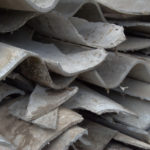Asbestos 101: Understanding the Risks of Asbestos Exposure

Asbestos is a set of six naturally occurring silicate minerals: amosite, crocidolite, chrysotile, tremolite, actinolite, and anthophyllite. Whether asbestos is inside a residential home or a commercial business, asbestos can represent a serious problem if it becomes friable and airborne. The reason is that asbestos can be associated with serious medical conditions if inhaled or ingested. Exposure to asbestos can lead to related diseases that can take years to develop. In fact, the latency period after exposure can be from 10 -15 years. A percentage of people, from 2% to 10%, who are exposed to asbestos will develop an asbestos-related disease.
Consequentially, if you are remodeling or adding to an existing public building, an asbestos survey is essential. If you are demolishing any building, an asbestos survey is required and if you are renovating a workspace or contracting to renovate a private dwelling, an asbestos survey is prudent. If you observe a suspected asbestos building material deteriorating and becoming airborne, or friable, an asbestos survey is urgent and corrective actions should be conducted immediately. Luckily, there are professionals, like Turn-Key Environmental, who perform asbestos hazard evaluations with testing and analysis. There are a few helpful facts to know about asbestos:
Asbestos History
Asbestos use dates back at least 4,500 years when inhabitants of East Finland strengthened earthenware cooking utensils with parts of asbestos. The mineral has been used extensively for its strength and fire-resistant characteristics. While the production of asbestos-containing materials became illegal to produce in the United States, many building materials in the U.S.A. are obtained from countries that do not have these regulations, therefore many recently built environments often contain asbestos threats when dust is created.
Asbestos Exposure Health Risks
Serious health risks are associated with asbestos exposure:
- Abnormalities (thickening and calcification) in the lining of the chest cavity.
- Lung cancer.
- Colorectal and gastrointestinal cancers.
- Mesothelioma (a form of cancer that invades the lining of the chest and abdomen and is extremely painful).
- Asbestosis (lung inflammation and buildup that can cause laughing, difficulty breathing, and permanent lung damage).
Types of Asbestos
There are two types of asbestos that are officially recognized by the U.S. Environmental Protection Agency (EPA):
- Amphibole asbestos — Crocidolite, amosite, anthophyllite, tremolite, and actinolite.
- Serpentine asbestos — Chrysotile.
Higher Risk Professions
There are occupations and industries that have traditionally seen workers exposed to significant levels of asbestos:
- Construction, renovation, and demolition of commercial and residential buildings.
- Janitorial jobs in structures that contain deteriorating asbestos.
- Shipbuilding.
- Roofing.
- Manufacture of products containing asbestos (it is currently legal to include asbestos in all types of American products as long as the product does not contain more than 1% asbestos).
- Paper mills.
- Mining.
- Automotive repair.
- Heating and cooling equipment repair.
Turn-Key Environmental Consultants can help. We have over 20 years of experience conducting asbestos hazard evaluation surveys, project abatement design, and oversight to ensure safe asbestos practices are being followed!


